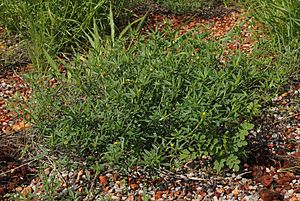Caribbean stylo facts for kids
Quick facts for kids Caribbean stylo |
|
|---|---|
 |
|
| Close-up of flower and leaves | |
 |
|
| Habit | |
| Scientific classification | |
| Genus: |
Stylosanthes
|
| Species: |
hamata
|
| Synonyms | |
|
List
|
|
Stylosanthes hamata, also known as the Caribbean stylo, is a type of flowering plant. It belongs to the Fabaceae family, which is also called the legume or pea family. This plant is special because it can help feed animals.
Contents
What is Caribbean Stylo?
The Caribbean stylo is a plant that grows in warm places. It has small flowers and green leaves. It is known for being a good source of food for livestock. Animals like cows and goats can eat it.
Where Does it Grow Naturally?
This plant originally comes from the islands of the Caribbean Sea. You can also find it in nearby mainland areas. These include countries like Mexico, Guatemala, Costa Rica, Colombia, and Venezuela.
Where Has it Been Introduced?
People have taken the Caribbean stylo to many other parts of the world. This is because it is a useful plant for farming. It has been introduced to places like:
- Florida, USA
- Peru and Brazil in South America
- Countries in Africa like The Gambia, Burkina Faso, and Benin
- Asian countries such as India, Thailand, and Hainan (an island in China)
- Northern Australia
Why is Caribbean Stylo Important?
Caribbean stylo is very important as a forage crop. A forage crop is a plant grown specifically to be eaten by farm animals. It helps farmers feed their animals, especially in areas where other plants might not grow well.
Types of Caribbean Stylo
There are different types, or cultivars, of Caribbean stylo. Scientists have found two main kinds:
- Diploid cultivars: These plants have a regular set of chromosomes.
- Tetraploid cultivars: These plants have double the usual set of chromosomes.
The tetraploid types are often better for pastures. They can handle dry weather much better. This means they are more drought tolerant. Farmers often choose these types when they need a plant that can survive with less water.

